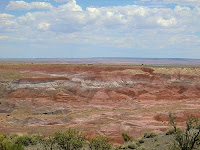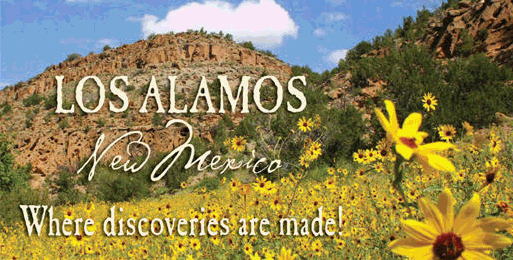
This morning we went on our first hike in the Red Rock Country. We headed to the "Red Rock Secret Mountain Wilderness" area in the northwest area of Sedona. We orginally were headed to the "Vultee Arch" Trail but the 4x4 road leading to it was 4 miles long and extremely rocky and bumpy so we turned around after only 1 mile. Instead, we went up the paved Dry Creek Road a bit farther and found another trailhead called "Fay Canyon." It was rated as "easy" in the FalconGuides book,
"Best Easy Day Hikes: Sedona."

The trail was beautiful, an easy walk through the pinon (spelled pinyon in AZ), cypress, manzanita, and juniper forest. Many flowers were along the trail but of course I didn't know what kind they were. Some of them were the same as what I see at home like the red penstemon (yes, I do know what those are called!). There were century plants (agave) and yucca plants too. We did see a lizard along the trail too.

Along the trail was supposed to be a side route that led to a natural rock arch. We attempted to find the arch but never could. I think we took the wrong side route and didn't want to scramble along the cliffs anymore so just went back to the main trail. Plus, Middle Son was REALLY done with the scrambling so we gave up.
The canyon was amazing with the vertical sandstone cliffs of the Schnebly Hill Formation rising on each side of us. The 270 million-year-old intertidal/beach formation contained a dune deposit and you can see the cross bedding within the layers at the top. The red bedded sandstone was amazing to see.

Now at the end of the trail is a dinosaur head-shaped rock. The end of the trail is also near a vortex location (one canyon over from us). As mentioned in a
previous blog, there are four vortexes in the Sedona area. Here in Fay Canyon, we enjoyed the experience of hiking and exploring, witnessing the beauty of the rocks and flora around us, but did we feel that special "energy?" As The Teenager said, "All I felt was hot and sweaty." Middle Son was annoyed with the fact that we were even hiking in the 80° (not counting humidity) heat. The 9-year-old constantly mentioned that it "smelled funny" along the trail. And since I was focused on all of the complaints, I felt nothing but annoyance during the 1.5 mile trek to the trail's end. But the hike back to the truck was better. The boys all stopped complaining and we were able to enjoy the trail experience. But a "Place of Power?" "Infinite wisdom?" Not so much.

After we got back in the truck, we drove to a lookout of Sedona's famous "Cathedral Rock," also made up entirely of the Schnebly Hill Formation. If you've seen any photos advertising Sedona, it is probably of this special rock formation (photo, left). We didn't drive all the way to the formation since it was getting later in the day but the view we got was spectacular. Another vortex location (two more to go!) with no extrasensory experiences except that The Teenager said his headache got better. Hummm.......
So our first morning of exploring this Red Rock Country was wonderful. A great way to start the vacation. I think we'll go back to Cathedral Rock with the rest of the family that we're vacationing with (they didn't want to get out and hike this morning, preferring to sleep in after the long drive yesterday). There are still two more vortex locations to check out and two more hiking trails that I'd like to go on that are in other parts of Sedona. Of course, we want a day at the Grand Canyon and maybe a trip to Meteor Crater. There's just so much to do and not enough time.
P.S. I discovered that "Upper R.R. Road" does not mean "Upper Rail Road Road." It means "Upper Red Rock Road." *embarrassed*
 Last night's dream was truly odd. I was on some sort of cruise ship, not alone, and we were searching for a place to eat. We ended up at one of those dinner shows and before I knew it, I was up on the stage singing! For one, I don't sing very well, and two, I'd never do it on a stage in front of an audience. I definitely have a fear of giving speeches and singing would be 10 times as scary! But there I was. I don't know what the song was, either. That would have been good to know.
Last night's dream was truly odd. I was on some sort of cruise ship, not alone, and we were searching for a place to eat. We ended up at one of those dinner shows and before I knew it, I was up on the stage singing! For one, I don't sing very well, and two, I'd never do it on a stage in front of an audience. I definitely have a fear of giving speeches and singing would be 10 times as scary! But there I was. I don't know what the song was, either. That would have been good to know.

















 Yesterday we spent the whole day at the south rim of Grand Canyon National Park. As I mentioned in a
Yesterday we spent the whole day at the south rim of Grand Canyon National Park. As I mentioned in a  Information on the Grand Canyon is all over the Internet and in many publications already so I won’t give an in-depth geologic history lesson here—just some basic facts.
Information on the Grand Canyon is all over the Internet and in many publications already so I won’t give an in-depth geologic history lesson here—just some basic facts. The Grand Canyon cuts down into the Colorado Plateau that stretches north to Utah, northeast to Colorado, and east to New Mexico. At the south rim, the elevation is 7,000 feet. The Canyon spans almost 2 billion years of time from the basement rocks of the Vishnu Schist to the 270 million year old Kaibab Limestone at the top. Below the Kaibab Limestone is the same Coconino Sandstone and Hermit Shale exposed in the Sedona rocks.
The Grand Canyon cuts down into the Colorado Plateau that stretches north to Utah, northeast to Colorado, and east to New Mexico. At the south rim, the elevation is 7,000 feet. The Canyon spans almost 2 billion years of time from the basement rocks of the Vishnu Schist to the 270 million year old Kaibab Limestone at the top. Below the Kaibab Limestone is the same Coconino Sandstone and Hermit Shale exposed in the Sedona rocks.





 This afternoon we drove out to Red Rock Crossing, accessible from a beautiful park called "Crescent Moon Ranch" along Oak Creek that has spectacular views of Cathedral Rock. I took some pictures with the sun shining on the rock formation before getting to the park but once we got to the park the sun went behind the clouds again. Nevertheless, I got some really beautiful pictures. I'd love to spend more time at the park wandering the trails.
This afternoon we drove out to Red Rock Crossing, accessible from a beautiful park called "Crescent Moon Ranch" along Oak Creek that has spectacular views of Cathedral Rock. I took some pictures with the sun shining on the rock formation before getting to the park but once we got to the park the sun went behind the clouds again. Nevertheless, I got some really beautiful pictures. I'd love to spend more time at the park wandering the trails.























